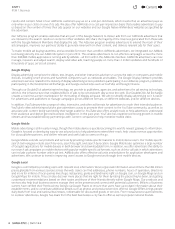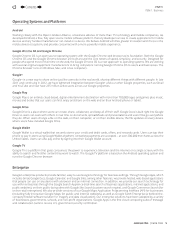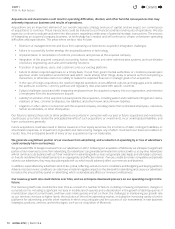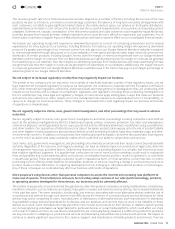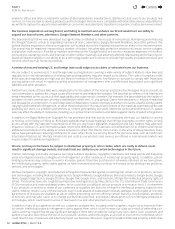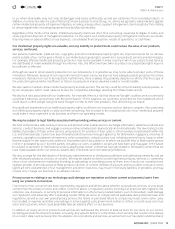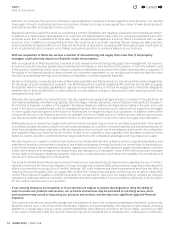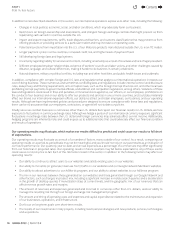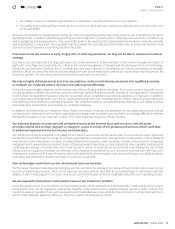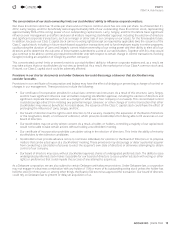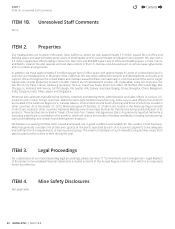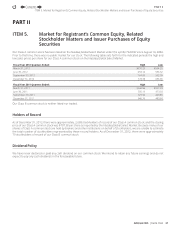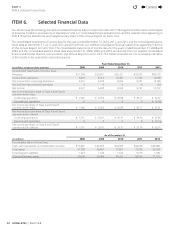Google 2012 Annual Report Download - page 20
Download and view the complete annual report
Please find page 20 of the 2012 Google annual report below. You can navigate through the pages in the report by either clicking on the pages listed below, or by using the keyword search tool below to find specific information within the annual report.
14 GOOGLE INC. | Form10-K
PART I
ITEM1A.Risk Factors
therefore, our business. We expect to continue to expend signifi cant resources to protect against security breaches. The risk that
these types of events could seriously harm our business is likely to increase as we expand the number of web-based products
and services we off er, and operate in more countries.
Regulatory authorities around the world are considering a number of legislative and regulatory proposals concerning data protection.
In addition, the interpretation and application of consumer and data protection laws in the U.S., Europe and elsewhere are often
uncertain and in fl ux. It is possible that these laws may be interpreted and applied in a manner that is inconsistent with our data
practices. If so, in addition to the possibility of fi nes, this could result in an order requiring that we change our data practices,
which could have an adverse eff ect on our business and results of operations. Complying with these various laws could cause us
to incur substantial costs or require us to change our business practices in a manner adverse to our business.
With our acquisition of Motorola, we face a number of manufacturing and supply chain risks that, if not properly
managed, could adversely impact our fi nancial results and prospects.
With our acquisition of Motorola, we face a number of risks related to manufacturing and supply chain management. For instance,
the products we sell may have quality issues resulting from the design or manufacture of the product, or from the software used
in the product. Sometimes, these issues may be caused by components we purchase from other manufacturers or suppliers. If
the quality of our Motorola products does not meet our customers’ expectations or our products are found to be defective, then
our sales and operating earnings, and ultimately our reputation, could be negatively impacted.
We rely on third parties to manufacture many of Motorola’s assemblies and fi nished products, and we have third-party arrangements
for the design of some components and parts. Our Motorola business could be negatively aff ected if we are not able to engage
third parties with the necessary capabilities or capacity on reasonable terms, or if those we engage fail to meet their obligations
(whether due to fi nancial di culties or other reasons), or make adverse changes in the pricing or other materials terms of our
arrangements with them.
Motorola, like many electronics manufacturers, has also experienced supply shortages and price increases in the past driven by
raw material availability, manufacturing capacity, labor shortages, industry allocations, natural disasters and signifi cant changes in
the fi nancial or business condition of its suppliers.Workaround plans to address shortages have entailed in the past, and could
entail in the future, increased freight costs for expedited shipments.We cannot assure you that we will not experience shortages
or other supply chain disruptions in the future or that they will not negatively impact our operations.In addition, some of the
components we use in our Motorola products are available only from a single source or limited sources, and we cannot assure
you that we would be able to fi nd replacement vendors on favorable terms or at all in the event of a supply chain disruption.
Additionally, because many of our supply contracts have volume-based pricing or minimum purchase requirements, if the volume
of our Motorola sales decreases or does not reach projected targets, we could face increased materials and manufacturing costs or
other fi nancial liabilities that could make our Motorola products more costly per unit to manufacture and therefore less competitive
and negatively impact our fi nancial results. Further, certain of our competitors may negotiate more favorable contractual terms
based on volume and other commitments that may provide them with competitive advantages and may impact our supply.
We also require our suppliers and business partners to comply with law and company policies regarding workplace and
employment practices, environmental compliance and intellectual property licensing, but we do not control them or their practices.
Ifanyofthemviolates laws or implements practices regarded as unethical, we could experience supply chain disruptions, canceled
orders, terminations of or damage to key relationships, and damage to our reputation. If any of them fails to procure necessary
license rights to third-party intellectual property, legal action could ensue that could impact the salability of our products and
expose us to fi nancial obligations to third parties.
The Dodd-Frank Wall Street Reform and Consumer Protection Act included disclosure requirements regarding the use of “confl ict”
minerals mined from the Democratic Republic of Congo and adjoining countries (DRC) and procedures regarding a manufacturer’s
eff orts to prevent the sourcing of such “confl ict” minerals. SEC rules implementing these requirements may have the eff ect of
reducing the pool of suppliers who can supply DRC “confl ict free” components and parts, and we may not be able to obtain DRC
confl ict free products or supplies in su cient quantities for our operations. Also, since our supply chain is complex, we may face
reputational challenges with our customers, stockholders and other stakeholders if we are unable to su ciently verify the origins
for the confl ict minerals used in our products.
If our security measures are breached, or if our services are subject to attacks that degrade or deny the ability of
users to access our products and services, our products and services may be perceived as not being secure, users
and customers may curtail or stop using our products and services, and we may incur signifi cant legal and fi nancial
exposure.
Our products and services involve the storage and transmission of users’ and customers’ proprietary information, and security
breaches expose us to a risk of loss of this information, litigation, and potential liability. We experience cyber attacks of varying
degrees on a regular basis, and as a result, unauthorized parties have obtained, and may in the future obtain, access to our data
or our users’ or customers’ data. Our security measures may also be breached due to employee error, malfeasance, or otherwise.
Contents
44


